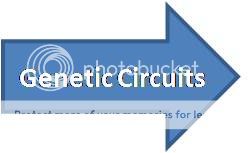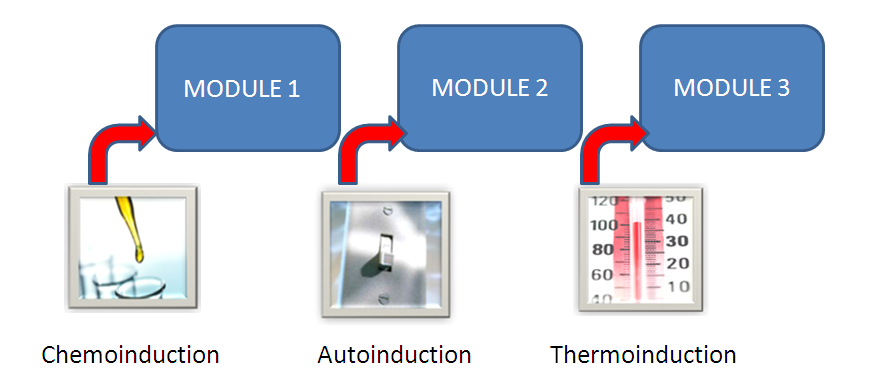Team:Imperial College London/Temporal Control
From 2009.igem.org
(→Our Results) |
m (→Project Tour) |
||
| (72 intermediate revisions not shown) | |||
| Line 1: | Line 1: | ||
{{Imperial/09/TemplateTop}} | {{Imperial/09/TemplateTop}} | ||
| - | =[[Image:II09_Temporal_control.png|50px]]<font face='Calibri' size='5'><b> | + | =[[Image:II09_Temporal_control.png|50px]]<font face='Calibri' size='5'><b>Module Integration</b></font>= |
| + | <html> | ||
| + | <div class="highslide-gallery" align="center"> | ||
| + | <a href="https://static.igem.org/mediawiki/2009/2/29/Ii09_tcg1.PNG" class="highslide" onclick="return hs.expand(this)"> | ||
| + | <img src="https://static.igem.org/mediawiki/2009/2/29/Ii09_tcg1.PNG" alt="" title="Testing Click to expand" width="100%"/> | ||
| + | </a> | ||
| + | <div class="highslide-caption"> | ||
| + | Temporal Control | ||
| + | </div> | ||
| + | </div> | ||
| + | </html> | ||
| + | <br> | ||
| + | <br> | ||
| + | <font face='Calibri' size='4'><b>Engineering Approach to Module Integration by <u>Temporal Control</u></b></font> | ||
| - | + | This <b>temporal control</b> platform showcases our engineering approach in the E.ncapsulator project. It allows us to integrate all our modules in a simple and elegant way. | |
| - | + | We’ve made our entire system <b>modular</b>, where we trigger the succession of events using this control system. Here, we have tackled a drug delivery problem, but this "Black box" approach can be applied to any other system. This is our <b>novel engineering approach</b>, which is extremely <b>reusable</b> in synthetic biology. | |
| - | We’ve made our entire system modular | + | |
| + | [[Image:II09_BlackBox3.png|400px|center]]<br> | ||
| - | + | <!--<html> | |
| + | <div class="highslide-gallery" align="center"> | ||
| + | <a href="https://static.igem.org/mediawiki/2009/3/3c/Ii09_tempotxt.PNG" class="highslide" onclick="return hs.expand(this)"> | ||
| + | <img src="https://static.igem.org/mediawiki/2009/3/3c/Ii09_tempotxt.PNG" alt="" title="Testing Click to expand" width="100%"/> | ||
| + | </a> | ||
| + | <div class="highslide-caption"> | ||
| + | Temporal Control | ||
| + | </div> | ||
| + | </div> | ||
| + | </html>--> | ||
| + | <!--====Testing Construct==== | ||
| + | This testing construct was used to test the inducible promoters using flourescent proteins as output reporters.<br> | ||
| - | + | <html> | |
| - | + | <div class="highslide-gallery" align="center"> | |
| - | + | <a href="https://static.igem.org/mediawiki/2009/0/0c/II09_Temp_Construct.png" class="highslide" onclick="return hs.expand(this)"> | |
| - | + | <img src="https://static.igem.org/mediawiki/2009/0/0c/II09_Temp_Construct.png" alt="" title="Testing Construct used for Temporal Control Timeline" width="50%"/> | |
| - | + | </a> | |
| - | + | <div class="highslide-caption"> | |
| - | + | Key to genetic circuit diagrams | |
| - | + | </div> | |
| - | + | </div> | |
| - | + | </html> | |
| - | + | ||
| - | + | ||
| - | + | ||
| - | + | ||
| - | + | ||
| - | + | ||
| - | + | ||
| - | + | ||
| - | + | ||
| - | + | ||
| + | --> | ||
===Timeline of Temporal Control=== | ===Timeline of Temporal Control=== | ||
| - | |||
This timeline shows the sequence of occurrence of these events: | This timeline shows the sequence of occurrence of these events: | ||
| - | <html> | + | <!--<html> |
<center> | <center> | ||
<div class="highslide-gallery"> | <div class="highslide-gallery"> | ||
<a href="https://static.igem.org/mediawiki/2009/1/15/II09_Timeline.png" class="highslide" onclick="return hs.expand(this)"> | <a href="https://static.igem.org/mediawiki/2009/1/15/II09_Timeline.png" class="highslide" onclick="return hs.expand(this)"> | ||
<img src="https://static.igem.org/mediawiki/2009/1/15/II09_Timeline.png" alt="" title="Module 3 is the destruction of the genetic material." width="95%"/> | <img src="https://static.igem.org/mediawiki/2009/1/15/II09_Timeline.png" alt="" title="Module 3 is the destruction of the genetic material." width="95%"/> | ||
| + | </a> | ||
| + | </div> | ||
| + | </center> | ||
| + | </html>--> | ||
| + | |||
| + | <html> | ||
| + | <center> | ||
| + | <div class="highslide-gallery"> | ||
| + | <a href="https://static.igem.org/mediawiki/2009/3/3d/Ii09_tcg4.PNG" class="highslide" onclick="return hs.expand(this)"> | ||
| + | <img src="https://static.igem.org/mediawiki/2009/3/3d/Ii09_tcg4.PNG" alt="" title="Module 3 is the destruction of the genetic material." width="95%"/> | ||
</a> | </a> | ||
</div> | </div> | ||
</center> | </center> | ||
</html> | </html> | ||
| + | |||
| + | <html> | ||
| + | <center> | ||
| + | <div class="highslide-gallery"> | ||
| + | <a href="https://static.igem.org/mediawiki/2009/7/7f/Ii09_tcg7.PNG" class="highslide" onclick="return hs.expand(this)"> | ||
| + | <img src="https://static.igem.org/mediawiki/2009/7/7f/Ii09_tcg7.PNG" alt="" title="Module 3 is the destruction of the genetic material." width="95%"/> | ||
| + | </a> | ||
| + | </div> | ||
| + | </center> | ||
| + | </html> | ||
| + | |||
| + | <html> | ||
| + | <center> | ||
| + | <div class="highslide-gallery"> | ||
| + | <a href="https://static.igem.org/mediawiki/2009/8/80/Ii09_tcg8.PNG" class="highslide" onclick="return hs.expand(this)"> | ||
| + | <img src="https://static.igem.org/mediawiki/2009/8/80/Ii09_tcg8.PNG" alt="" title="Module 3 is the destruction of the genetic material." width="95%"/> | ||
| + | </a> | ||
| + | </div> | ||
| + | </center> | ||
| + | </html> | ||
| + | |||
<html><a href="https://2009.igem.org/Team:Imperial_College_London/Temporal_Control/Graph#Explanation_of_Timeline | <html><a href="https://2009.igem.org/Team:Imperial_College_London/Temporal_Control/Graph#Explanation_of_Timeline | ||
| - | "><img style="vertical-align:bottom;" width=50px align="left" src="http://i691.photobucket.com/albums/vv271/dk806/ | + | "><img style="vertical-align:bottom;" width=50px align="left" src="http://i691.photobucket.com/albums/vv271/dk806/II09Learnmore.png"></a></html> <b>About the timeline, its explainations, and to view our testing construct.</b> |
<!--In our project there are 3 forms of temporal control that have been implemented. | <!--In our project there are 3 forms of temporal control that have been implemented. | ||
| Line 137: | Line 182: | ||
<br> | <br> | ||
| - | ===Our Results=== | + | <!--===Our Results=== |
| - | + | <u>Wetlab</u> | |
| - | |||
| - | + | //graph to be decided | |
| + | <html><a href="https://2009.igem.org/Team:Imperial_College_London/Wetlab/Results#Autoinduction | ||
| + | "><img style="vertical-align:bottom;" width=50px align="left" src="http://i691.photobucket.com/albums/vv271/dk806/II09Learnmore.png"></a></html> About the wetlab results! | ||
| - | + | <br> | |
| - | < | + | <u>Drylab</u> |
| + | [[Image:II09_diax_wolf.jpg | left]]We have modelled autoinduction by a number of models, and we hope that experimental results will confirm which model is most applicable to our system. | ||
| - | + | ||
| - | + | The first of our diauxic growth models is a cybernetic model developed by Kompala et al [1]. This model shows that glucose (S1) is used up before the secondary carbon source (S2). During this phase, the population (X) is in exponential grow until glucose (S1) runs out. This is followed by a stationary growth phase, and finally the population enters a second exponential growth phase as they start uptaking the secondary carbon source (S2). | |
| - | + | ||
| - | < | + | |
| - | < | + | <html><a href="https://2009.igem.org/Team:Imperial_College_London/Drylab/Autoinduction |
| - | + | "><img style="vertical-align:bottom;" width=50px align="left" src="http://i691.photobucket.com/albums/vv271/dk806/II09Learnmore.png"></a></html> about the models and simulations! | |
| - | < | + | |
| - | < | + | <br> <br> |
| - | <br> | + | |
| - | <br> | + | |
====References==== | ====References==== | ||
| Line 168: | Line 213: | ||
<center> | <center> | ||
| + | --> | ||
| - | === | + | ==Conclusion== |
| - | + | ||
| - | + | ||
| - | + | ||
| - | + | Module integration has allowed us to link all our modules together, to create a working network. | |
| - | + | It also allows us to showcase the advantages of <b>synthetic biology</b> as the <b>marriage of engineering with biology</b>. By integrating the engineering principles of reusability and simplicity of system, we have developed this platform to program biologcal systems. | |
| - | + | <br> | |
| + | <br> | ||
| + | <center> | ||
| + | ===Project Tour=== | ||
| + | <html><center><a href="https://2009.igem.org/Team:Imperial_College_London/M3"><img width=150px src="http://i691.photobucket.com/albums/vv271/dk806/Module3L.jpg"></a> | ||
| + | <a href="https://2009.igem.org/Team:Imperial_College_London/Genetic_Circuit"><img width=150px src="http://i691.photobucket.com/albums/vv271/dk806/GeneticCircuitsR.jpg"></a> | ||
| + | </html> | ||
| + | <hr> | ||
===Temporal Control Contents=== | ===Temporal Control Contents=== | ||
| - | <html><center><a href="https://2009.igem.org/Team:Imperial_College_London/Temporal_Control/ | + | <html><center><a href="https://2009.igem.org/Team:Imperial_College_London/Temporal_Control/Chemical_Induction"><img style="vertical-align:bottom;" width="20%" src="http://i691.photobucket.com/albums/vv271/dk806/II09_chemicalinduction.png"></a><a href="https://2009.igem.org/Team:Imperial_College_London/Temporal_Control/Autoinduction"><img style="vertical-align:bottom;" width="20%" src="http://i691.photobucket.com/albums/vv271/dk806/II09_Drylabmainimage1.png"></a><a href="https://2009.igem.org/Team:Imperial_College_London/Temporal_Control/Thermoinduction"><img style="vertical-align:bottom;" width="20%" src="http://i691.photobucket.com/albums/vv271/dk806/II09_Thermoinduction1.png"></a><a href="https://2009.igem.org/Team:Imperial_College_London/Wetlab/Results#Temporal_Control"><img style="vertical-align:bottom;"width="20%"src="http://i691.photobucket.com/albums/vv271/dk806/II09_Wetlabmainimage9.png"></a><a href="https://2009.igem.org/Team:Imperial_College_London/Drylab/Autoinduction"><img style="vertical-align:bottom;" width="20%" src="http://i691.photobucket.com/albums/vv271/dk806/II09_Drylabmainimage6.png"></a></center></html> |
<html><table border="0" style="background-color:transparent;" width="100%"> | <html><table border="0" style="background-color:transparent;" width="100%"> | ||
<tr><td width="0%"></td> | <tr><td width="0%"></td> | ||
| - | <td width=" | + | <td width="20%"><center><a href="https://2009.igem.org/Team:Imperial_College_London/Temporal_Control/Chemical_Induction"><b>Chemoinduction</b></a></center></td> |
| - | + | <td width="20%"><center><a href="https://2009.igem.org/Team:Imperial_College_London/Temporal_Control/Autoinduction"><b>Autoinduction</b></a></center></td> | |
| - | <td width=" | + | <td width="20%"><center><a href="https://2009.igem.org/Team:Imperial_College_London/Temporal_Control/Thermoinduction"><b>Thermoinduction</b></a></center></td> |
| - | <td width=" | + | <td width="20%"><center><a href="https://2009.igem.org/Team:Imperial_College_London/Wetlab/Results#Temporal_Control"><b>Wet Lab</b></a></center></td> |
| - | <td width=" | + | <td width="20%"><center><a href="https://2009.igem.org/Team:Imperial_College_London/Drylab/Autoinduction"><b>Modelling</b></a></center></td> |
| - | <td width=" | + | |
<tr><td width="1%"></td> | <tr><td width="1%"></td> | ||
Latest revision as of 01:00, 21 October 2009

Contents |
 Module Integration
Module Integration
Engineering Approach to Module Integration by Temporal Control
This temporal control platform showcases our engineering approach in the E.ncapsulator project. It allows us to integrate all our modules in a simple and elegant way.
We’ve made our entire system modular, where we trigger the succession of events using this control system. Here, we have tackled a drug delivery problem, but this "Black box" approach can be applied to any other system. This is our novel engineering approach, which is extremely reusable in synthetic biology.
Timeline of Temporal Control
This timeline shows the sequence of occurrence of these events:
 About the timeline, its explainations, and to view our testing construct.
About the timeline, its explainations, and to view our testing construct.
Conclusion
Module integration has allowed us to link all our modules together, to create a working network.
It also allows us to showcase the advantages of synthetic biology as the marriage of engineering with biology. By integrating the engineering principles of reusability and simplicity of system, we have developed this platform to program biologcal systems.
Project Tour


Temporal Control Contents





 "
"








